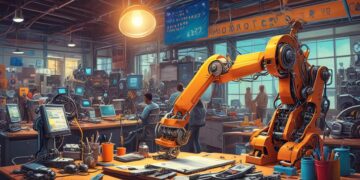The impact of automation on job growth and wages

Transformative Effects of Automation on Employment
The advent of automation technologies, including artificial intelligence (AI), robotics, and machine learning, has initiated profound changes across many sectors of the economy. These transformations have not only reshaped how industries operate but have also brought significant challenges and opportunities for the workforce. For instance, the manufacturing sector has seen an influx of robotic systems that can perform repetitive tasks with precision and efficiency, thereby enhancing productivity.
Job Displacement
One of the most immediate consequences of automation is job displacement. In industries such as manufacturing, many tasks that were traditionally performed by human workers are now handled by machines. According to a report from the World Economic Forum, it is estimated that 20 million manufacturing jobs worldwide could be lost to automation by 2030. In the United States, this trend is evident as factories increasingly implement robotic arms for welding, assembly, and quality control. Retail workers also face threats to their positions as self-checkout systems and automated inventory management reduce the need for human labor.
Creation of New Roles
Conversely, while automation can lead to the elimination of certain jobs, it simultaneously creates a demand for new roles. The technology sector, in particular, is experiencing a surge in job opportunities. As industries adopt new technologies, there is a growing need for skilled workers in fields such as data analysis, cybersecurity, and AI development. For example, positions such as machine learning engineers and data scientists are increasingly in demand, with salaries significantly higher than those in lower-skilled roles. This shift emphasizes the importance of workforce reskilling and upskilling to prepare employees for the roles of the future.
Wage Impacts
The rise of automation inevitably influences wage structures across the labor market. While automation may stunt wage growth in low-skilled positions—often because these roles can be easily replaced by machines—there are observable wage increases in positions that require technical skills and knowledge. As the demand for tech-savvy roles increases, organizations are willing to pay premium wages to attract qualified candidates. This growing disparity can lead to wage stagnation for workers lacking in technical skills, widening the income gap within the economy.
Policy Implications
Understanding the impacts of automation is essential for policymakers, employers, and workers. Policymakers must create frameworks that not only support the transition to an automated economy but also address the potential negative repercussions on employment. Initiatives such as education reforms, vocational training programs, and policies promoting workforce development are crucial to equip workers with the skills necessary for tomorrow’s job market. Employers are also encouraged to invest in training and development programs aimed at enhancing their workforce’s adaptability in the face of automation.
As automation continues to evolve, monitoring its trajectory will be essential in shaping a labor market that benefits all parties involved. By recognizing both the challenges and opportunities brought about by these technologies, stakeholders can work collaboratively to ensure sustainable growth and equitable job opportunities in the United States.
Understanding the Dual Nature of Automation
The ongoing integration of automation into the workforce presents a complex landscape characterized by both challenges and opportunities. As industries increasingly adopt automated processes, it is crucial to examine how these changes influence job creation, transformation, and wage structures. The resultant effects of automation are often multifaceted, leading to diverse implications across various sectors.
The Shift in Job Creation Dynamics
One of the notable outcomes of automation is the transformation of job creation dynamics. While certain roles, particularly those involving routine tasks, may decline, others emerge, particularly those requiring advanced technological expertise. The Bureau of Labor Statistics projects that sectors such as technology, healthcare, and renewable energy will see significant job growth due to automation and related innovations. For instance, roles in software development, health informatics, and advanced manufacturing are on the rise, highlighting a shift towards jobs that necessitate higher skill levels and adaptability.
- Technology Sector: The demand for roles such as software developers and AI specialists is surging. These positions often command high salaries that reflect the specialized skills they entail.
- Healthcare Sector: With the increasing reliance on technology in patient care, jobs in health analytics, telemedicine, and health IT are being created to address modern healthcare needs.
- Renewable Energy Sector: As the nation transitions towards sustainable energy sources, jobs related to renewable energy technologies, such as wind and solar, are expected to expand significantly.
This trend underscores the immediate need for targeted education and training initiatives aimed at preparing workers for these evolving roles. Employers, educational institutions, and government agencies must collaborate to create pathways that facilitate skill development, ensuring that the workforce is aligned with the labor market’s shifting demands.
The Impact on Wage Inequality
Automation also has profound implications for wage structures within the labor market. While there are opportunities for wage increases in high-demand, tech-oriented roles, there is a corresponding risk of wage stagnation for lower-skilled positions. Workers engaged in routine tasks, easily replaceable by machines, may find their wages constrained as the demand for these roles diminishes.
Data suggests a widening wage disparity driven by automation. Assessments indicate that approximately 70% of jobs that can be automated are typically lower-wage positions. Conversely, jobs requiring complex problem-solving and technological proficiency are associated with higher income potential. For instance, jobs in data science have an average salary exceeding $100,000 a year, while roles in basic assembly line work might yield around $30,000 annually. This growing bifurcation in income presents significant challenges, as those lacking in technical skills face diminishing economic mobility.
SEE MORE: How to Leverage Government Grants for Green Tech Projects
Adapting to the Changing Landscape
Addressing these challenges requires a proactive approach from all stakeholders in the economy. Workers must recognize the need for continual learning and upskilling. Employers are encouraged to implement training programs that not only prepare their workforce for current demands but also foster an environment conducive to lifelong learning. Lastly, policymakers must craft policies that facilitate this transition, potentially through funding education initiatives and encouraging apprenticeship programs that align training with market needs.
Strategic Responses to Automation in the Workforce
As the effects of automation weave deeper into various industries, stakeholders must adopt strategic responses that optimize the benefits of technological advancements while mitigating negative consequences. This multifaceted challenge necessitates not only immediate adjustments but also long-term planning that addresses the evolving nature of work.
Leveraging Technology for Workforce Enhancement
Automation should not solely be viewed as a means for cost reduction; rather, it can be harnessed effectively to enhance workforce capabilities. Businesses that invest in automation technologies can free up their employees from mundane tasks, allowing them to focus on creative problem-solving and higher-level decision-making. This shift can lead to increased productivity and job satisfaction. According to a 2022 McKinsey report, companies that implement automation strategically experience a workforce productivity boost averaging 35%.
Moreover, organizations employing automation technologies, such as artificial intelligence (AI) and machine learning, are laying the groundwork for new job roles that better fit the future labor market. For instance, firms in the manufacturing sector are increasingly utilizing smart robotics that require human oversight, thereby fostering roles in robotics maintenance and programming. By creating an environment that encourages the adoption of technology as a complement to human skills, businesses can enhance their talent pipeline and contribute to robust job growth.
The Importance of Lifelong Learning and Reskilling
The changing nature of work underscores the urgency of promoting a culture of lifelong learning. Data from the World Economic Forum indicates that by 2025, more than 85 million jobs may be displaced by the shift to automation, while 97 million new roles may emerge that are more adapted to the new division of labor. To ensure workers can transition into these emerging fields, edtech solutions and collaborative learning platforms are becoming essential tools.
Employers should actively participate in developing their workforce’s skills. This involves not only sponsoring training programs but also fostering partnerships with educational institutions. Community colleges and vocational programs play a pivotal role in delivering targeted training that aligns with the specific needs of local industries. For instance, initiatives in advanced manufacturing or IT can accelerate skill acquisition and ensure a steady supply of qualified personnel ready to meet the demands of a transforming job market.
SEE MORE: How to Leverage Government Grants for Green Tech Projects
Policy Interventions and Support Systems
Policymakers must take decisive actions to curb the potential downsides of automation, particularly regarding job displacement and wage inequality. Comprehensive policies focused on workforce development can create robust safety nets for affected workers. Examples include extended unemployment benefits, access to free or subsidized retraining programs, and investments in industries predicted to experience growth. Additionally, laws aimed at promoting fair wages across sectors will be critical in addressing wage stagnation.
In the United States, proposals for universal basic income (UBI) or targeted income support programs continue to gain traction. These initiatives could provide temporary financial relief for displaced workers, allowing them to seek retraining or new employment opportunities without the immediate anxiety of losing financial stability.
Overall, the multifaceted implications of automation demand an equally comprehensive approach from all sectors of society. By embracing technology, prioritizing continuous learning, and implementing supportive policies, the workforce can adapt to new realities and emerge more resilient amid the rapid evolution of the job market.
Conclusion
In summary, the impact of automation on job growth and wages presents a complex landscape that requires thoughtful consideration and proactive measures. As highlighted, while automation has the potential to create efficiencies and enhance productivity, it also poses challenges such as job displacement and wage stagnation for certain sectors. The duality of this evolution necessitates that businesses and policymakers work collaboratively to harness the benefits of automation while addressing its repercussions.
Encouragingly, the shift towards automation can lead to the emergence of new job opportunities, particularly as industries seek to fill roles that complement advanced technologies. However, for this shift to be successful, a robust framework of lifelong learning and reskilling must be established. This will equip workers with the necessary tools to transition into roles that align with future demands.
Furthermore, comprehensive policy interventions are critical to supporting vulnerable workers through this transition. By offering safety nets, funding education initiatives, and advocating for equitable wage policies, stakeholders can create an environment that leverages automation as a driver of not just productivity but also inclusive growth. Ultimately, by understanding the nuances of automation’s impact on the workforce and recognizing the need for strategic responses, society can pave the way for a future where both job growth and fair wages coexist harmoniously. This forward-thinking approach is essential for ensuring that the benefits of automation are widely shared, fostering a resilient labor market that thrives amid technological advancements.
SEE MORE: How to Leverage Government Grants for Green Tech Projects









